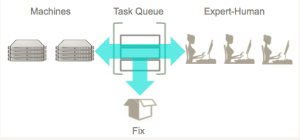Stitch Fix: Decoding fashion through analytic

How much easier would shopping be if a stylist mailed you five pieces of clothing that she tailored just for you, and you had the choice to buy what you like and mail the rest back for free?
Stitch Fix is highly effective in linking its business model with its operating model. The company figured out the recipe for mass customization as it is now providing a more practical and personalized shopping experience at a lower cost by marrying expert-human experience with proprietary machine-learning algorithms to filter and rank-order all the inventory on a customer basis.
Business Model:
Created in 2011, Stitch Fix is an exclusively online personal styling service for women which works with more than 200 labels [i, ii]. From a business model perspective, Stitch Fix is retail – that is, it buys inventory at wholesale cost and sell it at retail prices. However, the experience for the customer is very different from traditional brick and mortar retail or even e-commerce. It was established in order to facilitate the decision making process of shopping through curation and personalization.

How do I sign-up?
When a new customer signs up on Stitch Fix’s website, they are prompted to fill out a very detailed survey, also called “style profile” with questions that ask about their body type, fit and style preferences, life events, spending limits and more [i, iii].
What do I get?
– Customers who order a “Fix” pay a $20 styling fee per shipment, which entails 5 items.
– If they choose to purchase one or more of the items in their Fix, that $20 is applied as credit to the purchase. If the customer chooses to keep all five items in their “Fix”, they get a 25% discount off of the entire purchase. [iv]
– If the customer is unhappy with the “Fix”, they can return the entire package and will only be charged the initial $20 styling fee. [iv]
– Customers can request a shipment or can opt into a subscription (monthly, quarterly, etc.).
Operational Model:
Combining the power of more than 50 data scientists and more than 2,000 stylists [v] Stitch Fix bases their style predictions on customer data gathered from social media, personal questionnaire and feedback [v, vi].
Machine resources

Each attribute that describes a piece of merchandise (e.g. color, fit, style, etc.) is represented as data and reconciled to a client’s unique preferences. Machines do all the rote calculations (collaborative filtering, calculate priors, calculate distance and similarity measures, qualify, rank, sort, etc.). The output from machine processing is a set of scores representing the relevancy between the client and each piece of merchandise. The outcome of then informs the stylists of a customer’s specific needs [vi, vii].
The algorithms and mechanisms self-correct and are built reactively based on feedback data – therefore, the more a customer uses the service, the more accurate their shipments will be. According to CEO Katrina Lake, it took the company around 8-12 months to refine the model to deliver consistent results. [ii, viii]
Human resources
The results from the machine calculation are returned to a human stylist in the form of a “styling cockpit”, the stylist in turn uses her cognitive abilities to curate and further contextualize results based on customer unstructured data (e.g. images, videos, free form text etc.) [vi, vii]. While the algorithms help narrow down the options and apply linkages, the expert-stylists can empathize with the customer and provide them with a tailored experience. Today, over 80 percent of clients coming back within 90 days for a second order, and a third of clients spending 50 percent of their clothing walletshare with Stitch Fix [ix].
Linking the data
“Art & Science” [i] is one of the most prominent Stitch Fix values. By linking the machine-learning and algorithms with the expert-human taste and styling, Stitch Fix manages to achieve the perfect balance it promises, to reach its goal of mass customization.
Future outlook
In just a few years, Stitch Fix was successful in scaling its business model due to the efficiency of its operation and the understanding of its customers’ wants and needs. With multiple industry sources projecting that the company will generate more than $200 million in revenue this year [v], we can be sure that Stitch Fix has only scratched the surface of possibilities in retail.
Sources:
i. Stitch Fix website: https://www.stitchfix.com/about
ii. Mercury News – founder interview: http://www.mercurynews.com/business/ci_25344221/q-stitch-fix-founder-katrina-lake-melding-fashion
iii. Business Insider: http://www.businessinsider.com/stitch-fix-review-2015-3
iv. Harvard Business Review: https://hbr.org/2015/05/what-stitchfix-figured-out-about-mass-customization
v. Forbes: http://www.forbes.com/
vi. Multithreaded blog: http://multithreaded.stitchfix.com/blog/2014/07/21/machine-and-expert-human-resources/
vii. Quora: https://www.quora.com/How-does-the-Stitch-Fix-algorithm-work
viii. Fast Company: http://www.fastcompany.com/3009885/innovation-agents/stitch-fix-reluctant-pioneers-of-the-slow-startup-movement
ix. PSKF – The future of retail: http://www.psfk.com/2015/11/retail-trends-stitch-fix-artificial-intelligence-shopping.html



I love this post Sacha! It is amazing to see how they synthesize human expertise with data analytics (with objectivity) to create a fashion opinion on styling (which is usually subjective). The customer loyalty (repeat order rate and revenue generation) is also impressive. I guess my question would be on the customer acquisition part. Do you have any numbers on their growth in the last four years? How fast do you think they could grow their business through attracting new customers or do you think they should focus on building a loyal following and increase basket sizes from those customers?
Interesting company. it’s awesome that they could ‘pre-filter’ the choices, so that the expert curator could just finish of the process. But when they want to scale, don’t you think the curator will become the bottleneck? Do you think it’s better for Stitch Fix to just go ‘all algorithm’ to have endless scalability?
Great post and cool company… I agree with Garri… it will be interesting to see how they scale…